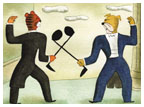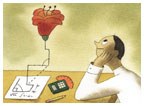To read our exclusively online On the Campus column, click here.
January 26, 2005: On the Campus
A rivalry changes its tune
By Christian R. Burset ’07
Engaging engineering
By Jen Albinson ’05
Illustration by Marc Rosenthal '71 |
By Christian R. Burset ’07
Blame the stuffed tiger. Lying across the piano during the 2003 Princeton-Yale Glee Club concert, perhaps it presented too tempting a target for the Yalies to pass up. Or maybe Yale sought retribution for the mockery dealt to it by Princeton’s skit.
Either way, a small but belligerent mob in white ties and tails burst onto the stage in Richardson Auditorium during the November 2003 show. Grabbing for the tiger and most other items in Princeton’s possession, the Yale singers initiated a tug-of-war that deteriorated into a miniature melee. Meanwhile, the besieged student conductor forged ahead with — appropriately — Princeton’s fight songs. Future historians may be inclined to compare the incident with the debut of Stravinsky’s riot-inducing Rite of Spring.
The skirmish was a particularly memorable incident in a long tradition of music and mockery that began before World War I, in which the Princeton, Harvard, and Yale Glee Clubs perform joint concerts the night before their football teams face off. Gridiron fans might wonder how Verdi and Vaughan Williams fit with football, but some Princetonians see these concerts as a highlight of the season. In his Oct. 21 column, Daily Princetonian sports editor Thad Hartmann ’05 recounted the spectacle of 2003’s Princeton-Yale scrap and predicted the Princeton-Harvard Glee Club concert would be the “sweetest matchup” of the weekend.
Yet spectators hoping to see a scuffle must have been disappointed, particularly at the noticeably calmer Princeton-Yale concert in New Haven last November. True, both choirs continued the tradition of performing fight songs, and Princeton presented a skit depicting a befuddled bulldog being tamed by a tiger. But the choirs stuck to their pledge to avoid pranks and disruptions during each other’s performances.
Jenn Greenlief ’05, who organized Princeton’s skit, found the concert anticlimactic. “The Yale concert is known for being very crazy,” she says, “but it was toned down this year.”
A high part of the concert was Princeton’s performance of “Orange Bubble, ” a song composed by Glee Club and Triangle Club member Drew Fornarola ’06 that humorously plays with the idea that “nothing ever happens in Princeton” . Though it had met with success at home, Fornarola wasn’t sure how the song would go over at Yale. (for lyrics, click here...)
“There’s a lot in there specifically about Princeton,” he says. “But it was received better than I could have imagined. I guess there’s a lot in common between the schools.”
Far from the cacophony of choral clashes, sophomore Maya Maskarinec enjoys a calmer musical custom. On Wednesdays, as students file out of noon Mass at the University Chapel, she walks inside and sits down to wait for the weekly organ concert to begin. Watching her classmates leave, she seems impervious to the demands of the classes and papers that would draw her back outside.
“It’s a nice time to get away from everything,” Maskarinec says.
If she weren’t so friendly, one would be tempted to think “everything” included her fellow students. Most weeks, Maskarinec is the only undergraduate present in the audience of about 75 mostly older community members.
That becomes irrelevant once the concert begins. With the organist hidden in the chancel, the chapel itself seems to play the baroque prelude. The building does not quite dance to the “Tango for Organ,” but it does seem to tap its foot.
“It’s as if you’re hearing a different instrument every time,” explains Penna Rose, director of chapel music. Organists choose their own arrangements so that each performance has a distinct texture.
Despite the beauty of both the chapel and the music, organ concerts
have never attracted many students. But the larger community provides
a grateful audience. “A nice thing about this university,”
Maskarinec says, “is that it keeps all these things, like organ
concerts, even though almost no undergraduates go to them.” ![]()
Christian R. Burset ’07, from Bernardsville, N.J., is a member of the Princeton Glee Club.
Illustration by Marc Rosenthal '71 |
By Jen Albinson ’05
With the University requiring that each undergraduate student take two courses in the “Science and Technology” category in order to graduate, most humanities students know the feeling of flipping endlessly through the Undergraduate Announcement in search of a good course to satisfy the requirement. Though the standard “Rocks for Jocks” and “Physics for Poets” options exist, some students dig deeper, in search of that science course that will be interesting and engaging, but still closer to history than to engineering. For those students, Professor David P. Billington ’50 has come to the rescue.
Billington began teaching at Princeton in 1958, and in his first decade, he got the sense that his architecture students disliked learning about traditional structural engineering. They wanted to “learn about beautiful structures,” he says, so on the advice of then-President Robert Goheen ’40 *48, he applied for a National Endowment for the Humanities grant to develop a course on such structures. Within a few years, he made the course accessible to liberal arts students, and enrollment shot up. Billington still teaches the class, Struc-tures and the Urban Environment, drawing large enrollments and great reviews.
In 1985, the engineering school charged Billington with revamping the introduction to engineering, and he created Engineering in the Modern World, a historical look at the major developments of engineering. The class has been popular with engineers and non-engineers alike. “I like both,” Billington says. “I really enjoy teaching liberal arts students, I’ve always liked that.” Jiffy Bennett ’05, one of his thesis advisees, says Billington doesn’t just like teaching liberal arts students — he has the power to convert them. “Every year,” she says, “more than a few students switch into engineering as a result of his courses.”
Billington’s classes are famous, not only for their material and broad appeal, but also for the professor himself. He dresses impeccably and, at age 77, still gives every lecture without the help of notes. Bennett says each of Billington’s seemingly extemporaneous lectures is a “carefully crafted story,” delivered as though it is a one-on-one conversation, despite course enrollments of roughly 200 students. Billington’s wife and children figure prominently in many of his slides, and he references them as his “research assistants” (or sometimes his “scale factors”).
Billington’s teaching has garnered honors from the National Academy of Engineering, the Carnegie Foundation, and the National Science Foundation within the last two years. But Bennett says his role with students transcends teaching. “He is not just an adviser,” she says. “He is a trusted mentor.”
Upon returning from the recent Ivy Council conference at Cornell University, Jay Saxon ’05 announced to the Under-graduate Student Government Senate that Princeton’s mail system is inefficient and, compared to other Ivies, its “housing is the most asinine process you can think of.” But, he says, Princeton undergrads have it good when it comes to the services at McCosh Health Center, and the perks don’t end there.
Saxon is Princeton’s head delegate to the Ivy Council, a group of representatives from each of the eight Ivy League schools that convenes twice annually to discuss the issues faced by students at their schools. Founded in 1993, the Ivy Council examines everything from campus safety to laundry costs. From its initial goal of sharing information and perspective across the Ivy League, the group has expanded to include a program called IvyCORPS, which supports outreach programs on Ivy League campuses, and the Ivy Leadership Summit, an annual conference where students discuss national issues. Princeton will host this year’s summit in February, focusing on “Health, Economy, and the International Community.”
Council delegate Edward Hoa ’07, an operations research and financial
engineering major from Los Altos, Calif., says he’s gained an “appreciation
for how cool Princeton is” through the group’s conferences.
Saxon agrees. When discussing the issues of student safety and transportation
on urban campuses, or the inaccessibility of professors and unnecessary
bureaucracy at peer institutions, Saxon says Princeton really is “this
side of paradise.” ![]()
Jen Albinson ’05 is a history major from Chevy Chase, Md.



